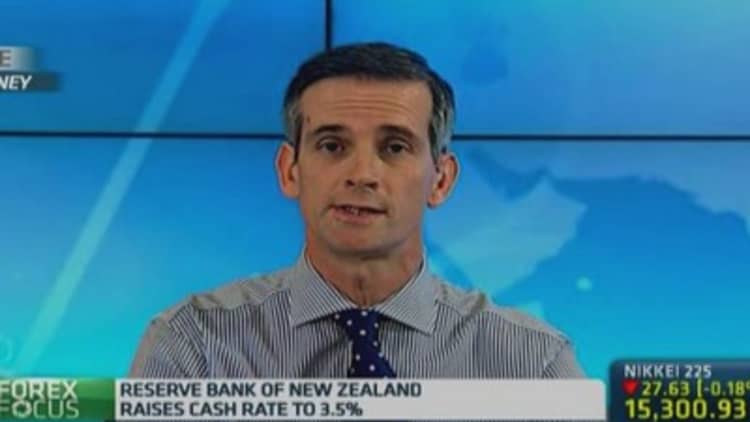
The , the current darling of foreign exchange investors, got crushed on Thursday as the country's central bank warned against the currency's strength following its decision to hike interest rates for a fourth time in 5 months.
The Reserve Bank of New Zealand [RBNZ] labeled the level of the kiwi dollar "unjustified" and "unsustainable," giving rise to expectations that it may intervene in markets to weaken the currency.
That sent the kiwi dollar hurtling down 1.2 percent against the U.S. dollar to $0.8594.
Read MoreKiwi dollar should be weaker: New Zealand Finance Minister
"The outsized reaction in the New Zealand dollar has come from the use of the word 'unjustified' in describing the strength of the currency," said Ray Attrill, co-head of FX strategy at National Australian Bank.
"Unjustified" strength is one of four criteria the central bank has mapped out to rationalize any intervention in the foreign exchange market.
The others are: the exchange rate must be exceptionally high or low, conditions in the market must be opportune to allow intervention a reasonable chance of success and intervention must be consistent with the Policy Targets Agreement (PTA) - a key element in the New Zealand monetary policy framework.
"The step up in rhetoric suggests the RBNZ's 'criteria for intervention' has been met. We're on notice the RBNZ may seek opportune periods to demonstrate the wider tools in their armory," said Sam Tuck, senior currency strategist at ANZ.
Read MoreMilk got your carry trade?
"Short NZD/USD positions have RBNZ support, as markets have been put on notice that further unjustified NZD strength may meet an official response from the RBNZ," he said.
Where to next for the kiwi?
The kiwi has appreciated 7.7 percent over the past year driven by strong domestic economic momentum, the country's terms of trade which is at a 40-year high and the central bank's commencement of interest rate hikes.
The central bank on raised its official lending rate on Thursday by 25 basis points to 3.50 percent, its highest level in more than five years. At 3.50 percent New Zealand's rates are well above the Fed fund's rate of 0.0 to 0.25 percent and even that of Australia which is at 2.50 percent.

However, strategists expect the currency to give back some of its recent gains, falling to as low as $0.80 by year-end.
Read MoreFlying Kiwi dollar to come 'down to earth': Goldman Sachs
Atrill says there are two main factors that will drive the currency lower: a stronger U.S. dollar as markets begin to factor in the impending Federal Reserve rate hike and the declining value of a key export – dairy products.
Two of the last three GlobalDairyTrade auctions showed "very poor results," with dairy prices racking up a year-to-date 28 percent decline, according to ANZ.
In addition, he notes that a dramatic escalation in geopolitical tensions in Ukraine and the Middle East also presents a potential risk for the currency.
Jim Devonport, corporate client manager at Compass Global Markets, doesn't see quite as sharp declines. He expects the kiwi dollar will edge lower to $0.85 on domestic factors such as weaker dairy prices, noting that losses will be capped by demand for the currency by yield chasers.
"All the good news for the currency has been priced in, so I can't see much further upside. But, I expect dips in the currency will be bought into, limiting downside," he said.


